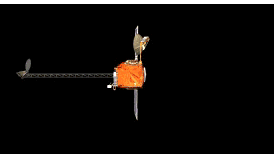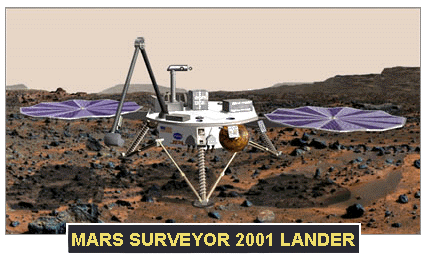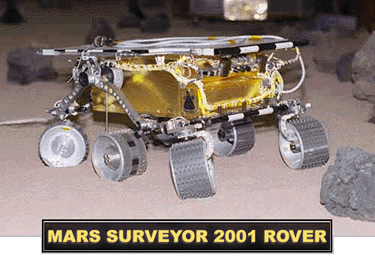Mars: A Century of Exploration
Future Probes to Mars
The three primary goals of future Mars explorations are
- the search for evidence of life, past or present,
- understanding long-term climatic change on Mars,
- surveying the planets natural resources, assessing in
particular their utility for future explorations.
The current epoch of exploration started in 1996 with the Mars Pathfinder
and Mars Global Surveyor.
 The Mars Surveyor 2001 Orbiter is scheduled for launch on April 18, 2001.
It will arrive at Mars on Oct. 27, 2001, if launched on schedule. The 2001
Orbiter will be the first to use the atmosphere of Mars to slow down and
directly capture a spacecraft into orbit in one step, using a technique
called aerocapture. It will then reach a circular mapping orbit within about
1 week after arrival. The Orbiter will carry 2 main science instruments,
the Thermal Emission Imaging System (THEMIS) and the Gamma Ray Spectrometer
(GRS). THEMIS will map the mineralogy and morphology of the Martian surface
using a high resolution camera and a thermal infrared imaging spectrometer.
The GRS will achieve global mapping of the elemental composition of the
surface and the abundance of hydrogen in the shallow subsurface. The gamma
ray spectrometer was inherited from the lost Mars Observer mission. The
2001 Orbiter will also support communication with the Lander and Rover
scheduled to arrive on January 22, 2002.
The Mars Surveyor 2001 Orbiter is scheduled for launch on April 18, 2001.
It will arrive at Mars on Oct. 27, 2001, if launched on schedule. The 2001
Orbiter will be the first to use the atmosphere of Mars to slow down and
directly capture a spacecraft into orbit in one step, using a technique
called aerocapture. It will then reach a circular mapping orbit within about
1 week after arrival. The Orbiter will carry 2 main science instruments,
the Thermal Emission Imaging System (THEMIS) and the Gamma Ray Spectrometer
(GRS). THEMIS will map the mineralogy and morphology of the Martian surface
using a high resolution camera and a thermal infrared imaging spectrometer.
The GRS will achieve global mapping of the elemental composition of the
surface and the abundance of hydrogen in the shallow subsurface. The gamma
ray spectrometer was inherited from the lost Mars Observer mission. The
2001 Orbiter will also support communication with the Lander and Rover
scheduled to arrive on January 22, 2002.
 The Mars Surveyor 2001 Lander is scheduled for launch on April 10, 2001.
It will land on Mars on Jan. 22, 2002, if launched on schedule. The 2001
Lander will carry an imager to take pictures of the surrounding terrain
during its' rocket-assisted descent to the surface. The descent imaging
camera will provide images of the landing site for geologic analyses, and
will aid planning for initial operations and traverses by the rover. The
2001 Lander will also be a platform for instruments and technology experiments
designed to provide key insights to decisions regarding successful and cost-effective
human missions to Mars. Hardware on the Lander will be used for an in-situ
demonstration test of rocket propellant production using gases in the Martian
atmosphere. Other equipment will characterize the Martian soil properties
and surface radiation environment.
The Mars Surveyor 2001 Lander is scheduled for launch on April 10, 2001.
It will land on Mars on Jan. 22, 2002, if launched on schedule. The 2001
Lander will carry an imager to take pictures of the surrounding terrain
during its' rocket-assisted descent to the surface. The descent imaging
camera will provide images of the landing site for geologic analyses, and
will aid planning for initial operations and traverses by the rover. The
2001 Lander will also be a platform for instruments and technology experiments
designed to provide key insights to decisions regarding successful and cost-effective
human missions to Mars. Hardware on the Lander will be used for an in-situ
demonstration test of rocket propellant production using gases in the Martian
atmosphere. Other equipment will characterize the Martian soil properties
and surface radiation environment.
 As part of the 2001 mission redesign, the plans for the 2001 Rover have
changed significantly. Current plans are to send the so-named
Marie Curie rover to
Mars on the 2001 lander. This rover is very similar to the Pathfinder Sojourner
Rover.
As part of the 2001 mission redesign, the plans for the 2001 Rover have
changed significantly. Current plans are to send the so-named
Marie Curie rover to
Mars on the 2001 lander. This rover is very similar to the Pathfinder Sojourner
Rover.
Go to
next section.



